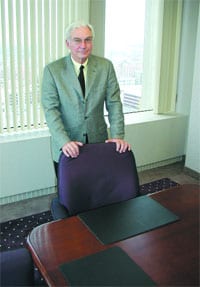A Different Kind of Malpractice Law Today, Medical Liability Means Never Having to Say You’re Sorry
Could the Bay State’s malpractice problem — and the soaring costs that accompany it — be solved with more openness and civility between doctors and injured patients? Some proponents of changing the current system think so.
It’s been well-documented that Massachusetts’ system of medical malpractice has forced doctors in high-risk specialties, such as obstetrics and neurosurgery, to pay more than $100,000 in annual insurance premiums — while forcing many others out of the state entirely.
“It’s been shown time and again that when malpractice premiums are high, the physician workforce shrinks, and patients have less access to the care they need,” said Dr. Kenneth Peelle, president of the Mass. Medical Society (MMS). “The current medical liability system is not working for physicians and definitely not for patients.”
Peelle cited the typical long stretch between the filing of a malpractice claim and its resolution — five years on average — and cited a study suggesting that the system pays one-quarter of the people without a legitimate claim, and doesn’t pay one-quarter of the people with a legitimate claim.
“We think the current system is badly broken, and it’s broken from the patient’s perspective,” agreed Dr. Alan Woodward, a former MMS president who now chairs the group’s task force on liability reform.
He noted that only one of every 16 injured patients ever sees money, and it’s not unusual for a monetary award in one case to be 40 times that in another, very similar case. “That’s jackpot justice,” he said. “And it’s justice delayed — and we think that’s justice denied.”
Woodward further explained that the system is heavy on overhead, meaning about 30{06cf2b9696b159f874511d23dbc893eb1ac83014175ed30550cfff22781411e5} of award money actually goes to plaintiffs, with more than 60{06cf2b9696b159f874511d23dbc893eb1ac83014175ed30550cfff22781411e5} going to lawyers, expert witnesses, and layers of administrative infrastructure.
There is a better way, he claimed, one that promotes openness between doctors and injured patients, while meting out justice more consistently and with an eye on improving safety in medical settings.
This month, The Healthcare News delves into the concept of health courts, and the establishment of a climate in which doctors aren’t afraid to tell patients they’re sorry. But first, let’s take a look at how the typical malpractice case is judged today.
Long Road
In Massachusetts, all malpractice cases have to be approved by a three-member tribunal, made up of a judge, a lawyer, and a doctor. The physician must be in the same field as the defendant doctor but from a different county.
At the tribunal hearing, the plaintiff must provide expert testimony from a doctor. Without this testimony and the favor of the tribunal, the suit may still proceed, but the plaintiff must put up a $10,000 bond. If he loses the case, he loses the money.
Once the case moves to trial, several standards need to be met to formulate a successful malpractice case, beginning with what type of duty the doctor owes to the patient, said Ronald Kidd, an attorney with Robinson Donovan in Springfield who specializes in malpractice.
“When you get in a car and go out on the road, you owe the duty of a reasonably prudent driver to everyone else on the highway — prudent, but not perfect. That’s a critical concept,” he explained. “In almost all cases, a similar duty is owed by a health care provider to a patient.”
The second factor, obviously, is whether a breach of that duty has occurred. That could mean one of two things, Kidd said: a doctor doing something that a reasonably prudent physician would not have done if faced with the same or similar circumstances, or failing to do something that a reasonably prudent physician would have done.
The other two factors are harm, and whether there is what Kidd calls a “proximate causal relationship” between the breach and the type of harm that resulted. And because this area can get technical, often requiring some knowledge of medical practice, both sides in a malpractice case will rely on expert testimony, typically from other physicians, to make their case.
“That’s one place a medical malpractice claim differs from a typical tort claim,” Kidd said. “In a normal situation, a juror, in the absence of any expert opinion, can decide whether it was negligence to leave a rollerskate out on the porch where the letter carrier could step on it, or negligence for you to be on the wrong side of the road when the accident occurred.
“But jurors are usually not competent, in the absence of expert testimony, to decide whether a doctor failed to meet the standard of a reasonably prudent physician faced with the same or similar circumstances,” and whether an error in judgment directly resulted in harm, he added.
The law requires expert opinion in such situations — typically someone from the same specialty as the defendant, although that isn’t exclusively the case. Such witnesses on both sides help convince a jury whether or not a doctor acted within the accepted standard of care.
Some tricky instances arise, Kidd noted, when that standard changes over time, which it does in many situations. Take, for example, prostate cancer.
This condition can be detected with a test of a protein called the prostate-specific antigen, or PSA. “It has long been understood that elevated PSA in the adult male is suspicious for the presence of prostate cancer, and would warrant further evaluation,” Kidd said.
But how elevated? In the past, physicians called for further tests when a man’s PSA measured 10 or more nanograms per milliliter of blood. Today, the standard is 4. If a patient sued after a physician failed to order further evaluation, a question might then arise as to when the test took place, before or after the standard changed.
“You can’t expect that, the day after this is published in the New England Journal of Medicine, that this becomes the standard of care for every practice in the commonwealth,” Kidd said. “What is a deviation today might not have been three years ago. Reasonable people can differ over what is the standard of care.”
Let’s Talk
However, that very concept — reasonable people differing — is exactly what’s being lost in the current malpractice climate, Woodward said.
“There’s a culture of silence,” he told The Healthcare News. “You’re told to talk only to your lawyer, and you can’t attempt dialogue that might improve patient safety and prevent a reoccurrence. This system thwarts direct communication.”
Part of the reason is that any kind of contrition on the doctor’s part may be used against him in court, which is why Woodward supports an “I’m sorry law” that would make physician apologies inadmissible in court. “An apology can be therapeutic to both parties,” he said. “In this situation, it’s an important part of the doctor-patient relationship.”
Such a law is just one part of a plan proposed earlier this year by Lt. Gov. Kerry Healey and endorsed by the MMS. Other elements in the plan include tightening the tribunal system to make the standard of proof of negligence more difficult before a claim can proceed; a hard cap of $500,000 on non-economic damages; a reduction in attorney fees from 25{06cf2b9696b159f874511d23dbc893eb1ac83014175ed30550cfff22781411e5} for verdicts over $500,000 to 15{06cf2b9696b159f874511d23dbc893eb1ac83014175ed30550cfff22781411e5} for verdicts over $600,000; and the funding of a patient safety initiative through the Betsy Lehman Center for Patient Safety and Medical Error Reduction.
The bill had made no headway even before the recent elections, and now that Healey is part of a lame-duck administration, it has no chance. But Woodward would not stop with those recommendations.
He sat on a task force of the Joint Committee on the Accreditation of Healthcare Organizations (JCAHO), which was tasked with improving patient safety across all institutions. They talked about ideas that have been around awhile, such as electronic order entry, but they had some more radical ideas in mind as well — including full disclosure of medical errors and apologies to patients.
Those changes should, in the opinion of the task force, come as part of a complete overhaul of medical liability, one that replaces the current climate of mistrust and gag orders with one of openness and constant improvement.
“We are looking at a system of health courts where we have experts rather than the general court hear cases,” Woodward said. “Medical testimony is often beyond the expertise and understanding of the average person, so it’s better to have someone well-educated and versed in this type of litigation.”
Proponents of such a system envision appropriate, consistent compensation being paid more quickly to patients who merit it, and doctors allowed to speak with — and apologize to — those who have suffered wrong, all the while striving to fix the problem instead of wishing it away through a wall of lawyers.
“When it comes to litigation, when we ask patients what they want, it’s full disclosure and an apology — and to make sure it doesn’t happen again to someone else,” Woodward said. “They also want fair economic compensation, which they clearly deserve, and a system like this has the potential to compensate many more patients than 1 in 16.”
Culture Shock
However, it’s not just the liability landscape keeping doctors from saying they’re sorry; it’s the very culture in which they were trained, said Thomas Gallagher, an associate professor of medicine at the University of Washington. “The vast majority of doctors haven’t had any training in disclosure, and these conversations are really difficult.”
A recent survey revealed that 94{06cf2b9696b159f874511d23dbc893eb1ac83014175ed30550cfff22781411e5} of doctors would be willing to disclose an error if it did not increase the risk of litigation, said Cecil Wilson, board chair of the American Medical Association (AMA).
“Patients deserve to know, and the AMA supports that, but in practice, disclosure may not be as frequent and complete as it should be,” Wilson said. “Our perception is that fear of medical liability litigation is one of the major deterrents.”
But something needs to be done, Woodward said, if only to stem the growing physician shortage in Massachusetts — and to allow the doctors who remain to work confidently and without fear.
“If they view new patients as potential litigants, they practice more defensive medicine, which costs this country more than $100 billion a year in tests and consultations doctors wouldn’t order if they weren’t worried about legal ramifications,” Woodward said.
“We have to do what we can to change this system,” he concluded. “It’s obviously broken to those who look at it objectively. We need a kinder, gentler, more efficient, and more just system for everybody — both physicians and patients.”


